Genre: Shmup Developer: Toaplan Publisher: Sega Enterprises Players: 1 Released: 1988
The first time I saw the arcade game Truxton, the power that the player’s ship could wield truly awed me: seeing five huge beams of lightning pour from my ship and command most of the screen, then lock, track, and pummel a boss while I zigged and zagged to avoid incoming bullets was an absolute blast. The Genesis port of the game faithfully replicates the joy of the arcade game, and despite attempts to squeeze the game layout into a screen that has been chopped vertically, smart design concessions in the port largely offset the unavoidable drawbacks, resulting in a great game.
Truxton is a top-down shmup: all the action takes place in the left three-quarters of the screen, the far-right quarter being reserved for player data. This sectioning of the screen to emulate the arcade’s aspect ratio is common among Genesis ports of arcades with portrait-type monitors, but the effort didn’t result in a perfect match here: the arcade screen’s height is about 8.5 ship-lengths whereas the Genesis version’s height is 6.5. Combine with this the fact that the enemy and player ships are big sprites anyway, and it’s understandable that the player feel a persistent claustrophobia that compels them to keep station at the bottom edge of the screen. Taken by itself, this is not a big deal, but Truxton, like most shmups, gives the player no warning of rear-approaching enemies. Most players, without investing a certain amount of time memorizing where rear-approaching enemies appear, will likely become incredibly frustrated to find themselves repeatedly sodomized, then insult added to injury as they are assaulted by the most demonic, bass-heavy, death-knell explosion sound the Genesis ever produced.
The game’s level design is minimalistic: the game scrolls along, never pausing or breaking its slow, steady pace until the final boss. The player blasts slow-moving, slow-to-shoot popcorn baddies, occasionally fighting a somewhat more unique enemy or even several mini-bosses at once; boss battles occur near the end of each stage. Stages flow together with nothing more obtrusive than a music change to indicate that you’ve advanced to the next level–not even destroying a stage’s boss is sufficient to advance due to the game’s incredibly annoying checkpoint system. Quite often, dying as much as thirty seconds after defeating a boss will mean you’re sent back and have to fight that boss again without the power-ups you had on the first encounter. Strangely, on rare occasion, dying actually sends you ahead to a point that you haven’t yet played. Also, the checkpoints are often set up such that dying a second time within a few seconds of respawning actually sends you backwards again to an even earlier checkpoint; this is usually annoying and only rarely useful for accumulating power ups.
The power up system is what justifies Truxton’s place in the shmup fan’s game library; your ship can fire one of three main weapons: power-shot (red), sun-laser (green), and the Tatsujin-beam (blue). Weapon-change icons are plentiful, and the power level of your current weapon is maintained when you switch. The power-shot is the default beam you start and respawn with–it’s a good compromise between forward-directed raw firepower and popcorn-eliminating dispersion-fire. The sun-laser fires only directly forward, but is typically more powerful than default, whereas the less-powerful Tatsujin-beam commands larger and larger arcs of the screen as it’s upgraded–the player may hold down either fire button to release a constant stream of lightning, and each individual bolt locks and tracks any enemy that it strikes until it’s destroyed.
You must collect a hard-won set of five power ups in order to upgrade your guns just once, though power-ups not yet exchanged for upgrades are carried over when you die. The first upgrade will enable your ship’s two wing-mounted turrets, tripling the fire-power of any weapon. Five power-ups later, the second upgrade will launch your ship’s satellite turrets to fly in formation at your wing-tips. For the sun-laser and Tatsujin-beam, the second upgrade is a straight-forward addition of another two beams. The power-shot, though, has a more useful second upgrade: each satellite fires a shot which travels quickly around your ship, so firing continuously will provide complete protection from being rammed by popcorn so long as your ship stays far enough from any edge of the screen that the satellites’ shots remain on-screen. Unfortunately, this upgrade doesn’t protect from enemy fire, nor from bosses or mini-bosses intent on ramming your ship; it’s also extremely difficult to use as an offensive weapon against bosses.
The controls are straight-forward and responsive: the D-pad moves your ship, the A button fires once, the B button drops bombs, and the C button serves as rapid-fire. Fortunately, it seems a decision was made to help players of the Genesis version to overcome the claustrophobic screen dimensions: the rapid-fire of the C-button is unique to the console port, and honestly indispensable. Also, though the bombs in both the arcade and Genesis versions heavily damage all enemy ships in range and destroy all enemy fire they come in contact with, only the Genesis version’s is a full-screen smart-bomb. Another minor upgrade is that the Tatsujin beam in the Genesis port always holds a lock on enemies, whereas it loses its lock regularly in the arcade.
Truxton on Genesis is a great game with tons of replay value for shmup fans. The graphics – though not outstanding – are solid 16-bit fare, the sound and music are slightly above average, and the controls are perfect. Truxton is well worth collecting and playing, despite some frustration caused by unavoidable design compromises.
SCORE: 8 out of 10

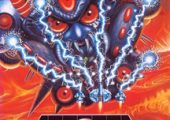
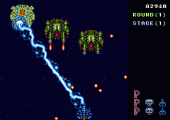
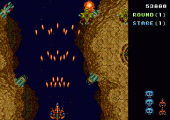
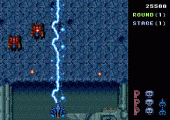
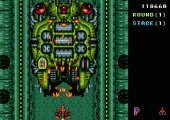
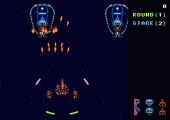
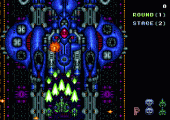
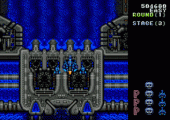
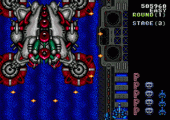
Rainbow Circle shot doesn’t exist in the arcade version but it makes this game much easier (as in more fair) for dealing with the behind the back of the ship attacks. It’s worth noting that Round 1 is only half the difficulty of the arcade and the actual arcade difficulty starts in Round 2.
Lots of fun. Love this game